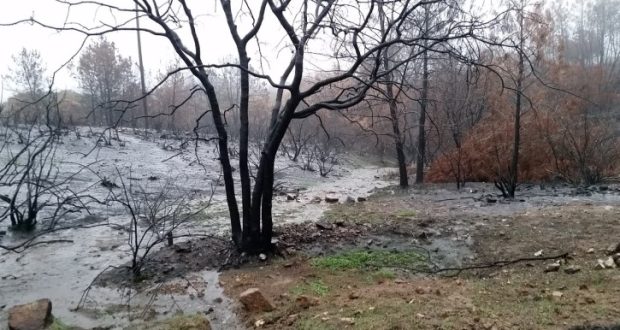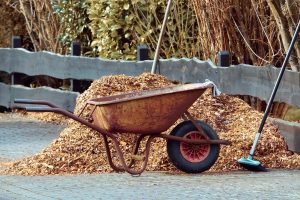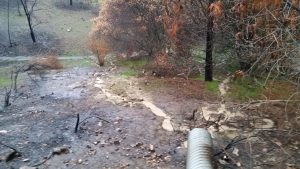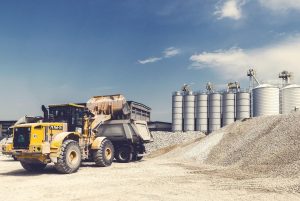By Tery Susman, UC Master Gardener of Mariposa County.
MARIPOSA — Wildfires can create immediate and potentially long-term soil erosion. However, there are a number of ways to mitigate this post-fire concern.
 The following has been adapted from the California Native Plant Society Fire Recovery Guide.
The following has been adapted from the California Native Plant Society Fire Recovery Guide.
1. Leave the mess; keep it under cover.
Much needed soil protection is provided by what the fire left behind. Ash, debris, fallen heat damaged leaves as well as the charred remains of plants can protect the land from wind and water erosion.
If a fire has burned so severely that no material is left on the ground, patches of soil form a crust and become hydroponic (water repellent), increasing runoff. This might necessitate applying chips, mulch from dead debris or straw.
Spreading mulch is the most effective erosion control treatment because it provides what the fire and heavy equipment removed: ground cover! This ground cover allows water to infiltrate the soil instead of running off and eroding it.
Prune or remove only high hazard fire-damaged trees near buildings and roads. Keep felled trees and pruning on-site. These trees can be a source of mulch.
2. Minimize soil compaction.
Keep foot traffic and equipment off burned landscape. Activity on slopes increases erosion weakening soil’s bonds, dislodging soil particles, and trampling newly sprouted plants. Activity on flat ground can compact the soil and lower its water absorption rates, which increases runoff.
3. Successful Strategies
Spread: A mulch application. Straw mulch has high efficacy in reducing rainwater runoff, soil erosion, and downstream sedimentation. Use loose barley or wheat straw because it is longer lasting. Rice straw is less expensive. Use when the straw doesn’t need to last as long. Use straw mulch in “free form”, no more than 2-3 inches deep. Mulch in 6-10 foot strips along contour, spaced at 50-100 foot intervals, depending on the steepness of the slope.
Use wood mulch from local materials, including burned trees, shredded debris, or thinned, unburned trees, wattles, mulch, rocks, and branches can slow down and disperse the runoff, limiting erosion and sediment.
Use straw wattles to shorten slope length. They are designed for short slopes or slopes flatter than 3:1 and low surface flows.
Sink: Place rocks, gravel, or crushed rock in areas of high traffic.
Share: Work with neighbors to create a plan to slow runoff. In disturbed areas of moderate to high fire intensity, a neighborhood plan can be critical in preventing sediment and fire debris from washing into sensitive creek habitats and contributing to flooding.
4. Seek advice: There are many professionals available to assist with on-site fire damage. If you are concerned that your property may be at risk from flooding or debris flow, reach out to these organizations:
Natural Resources Conservation Services: Visit them at nrcs.usda.gov/wps/portal/nrcs/site/national/home or call 209-966-3431.
![]() CAL Fire: Visit them at fire.ca.gov or call 209-966-3622.
CAL Fire: Visit them at fire.ca.gov or call 209-966-3622.
Recovering from a wildfire can be a daunting process. Be patient with yourself and with nature. Do what you can, ask for help, and know that our community is STRONG!
Next: Give Trees a Chance – Ecosystem Resilience
About UC Master Gardeners of Mariposa County
UC Master Gardeners of Mariposa County are located at 5009 Fairgrounds Road, Mariposa. For more gardening and event information, visit their website or Facebook page (UC Master Gardeners of Mariposa County).
UC Master Gardeners staff a helpline serving Mariposa County, including Greeley Hill, Coulterville, and Lake Don Pedro. Please contact them at 209-966-7078 or via e-mail at mgmariposa@ucdavis.edu.
Listen to them on the radio at KRYZ 98.5 FM on Wednesdays at 2 p.m and Saturdays at 5 p.m.
Check out this short video on how to manage water drainage on your property!







